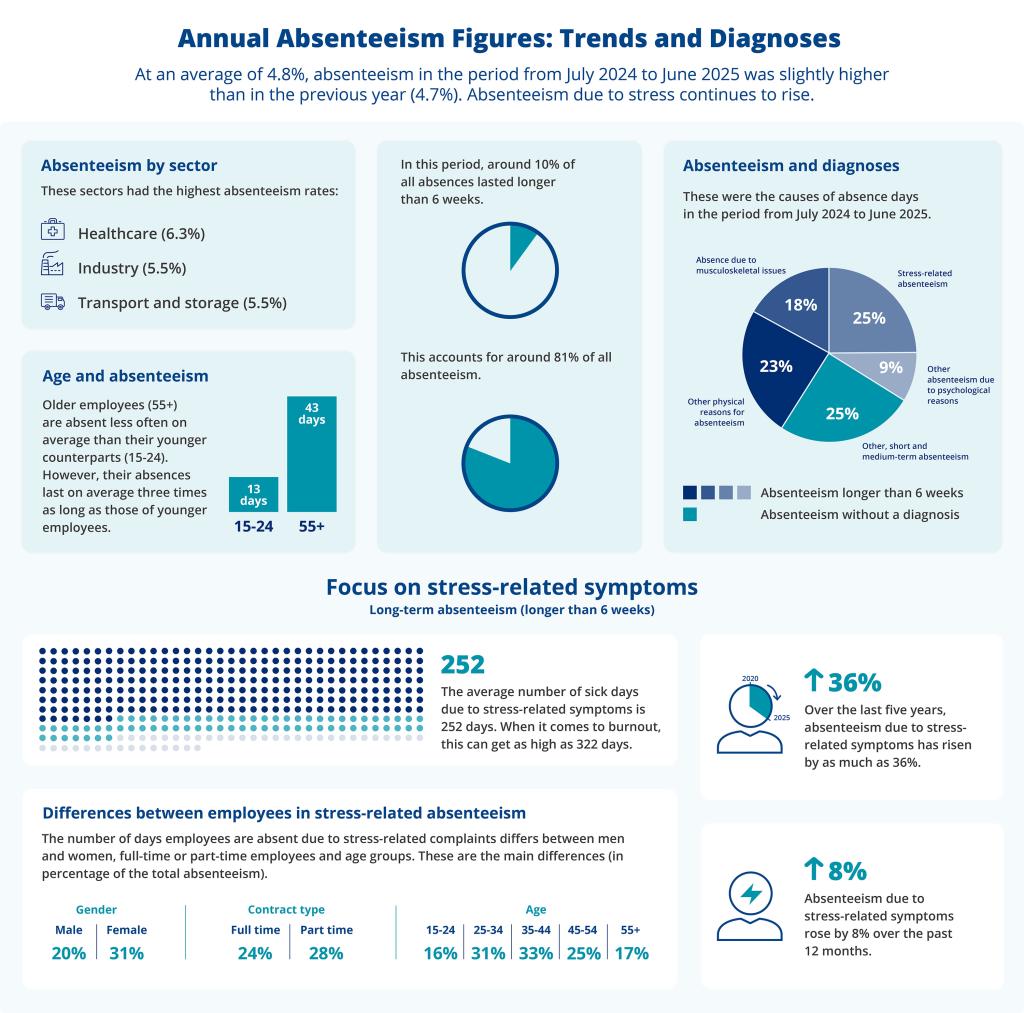Absence due to stress continues to rise

Absenteeism rates are rising; stress-related symptoms stand out
The overall average absenteeism rate between July 2024 and June 2025 stood at 4.8%, up slightly from the previous 12 months (4.7%). The healthcare, industrial and transport & storage sectors had the highest absenteeism rates. Approximately 10% of all sick leave lasted longer than six weeks, but at the same time this group accounts for as much as 81% of all absenteeism days. When zooming in on the causes of overall absenteeism in the Netherlands, one factor stands out above the rest: stress-related absence.
Urgency and social impact
One in four absence days is related to stress, and the duration of this absence continues to increase every year. This puts enormous pressure on employees, employers and our social security system. The public debate on this topic is intensifying. “The number of people that are incapacitated for work is expected to rise further in the coming years,” says Iris Homeijer, Occupational Physician and Director of Medical Affairs at HumanCapitalCare. “For small business owners, this is making long-term absenteeism increasingly difficult to bear. But larger organisations are also feeling the effects. They are experiencing more pressure on teams and rising costs for replacement and reintegration.”
Range of causes and complex context
Stress-related symptoms have a variety of causes relating to work, home life and society. Figures from ArboNed and HumanCapitalCare reveal significant differences between industries. For instance, stress-related absenteeism is highest in the healthcare sector. Furthermore, large organisations have more stress-related absenteeism on average than SMEs, but the impact is often more severely felt by small business owners. Comparatively, women take more days off work due to stress-related symptoms than men (31% vs 20%), and part-time employees take more days off than full-time employees (28% vs 24%). In addition, factors such as stage of life, personality traits, resilience, and personal circumstances – such as informal caregiving or divorce – also play a role. Social trends also increase the pressure, such as the ‘always-on’ culture caused by digitalisation, ageing populations, and uncertainties related to job security, labour market shortages, and changes in technology.
No simple solution, but a shared responsibility
Stress-related absenteeism is a major social problem that affects individuals, organisations, and society as a whole. “The urgency is clear, but there is no standard solution for such a complex issue,” Homeijer emphasises. “An effective approach to absenteeism always requires a customised solution, tailored to both the context of the organisation and the personal situation of the employee. Prevention is still too often overlooked, and there is a lack of structural cooperation—yet that is precisely where there is much to be gained.”
From a joint approach to concrete action
To achieve these gains, it is crucial for employers and employees to both take responsibility. Employers can offer support through flexible working arrangements or by facilitating professional help, even when stress originates from private situations. In addition, preventive tools such as the RI&E and the PMO help to identify risks at an early stage, enabling employers to take targeted action. It is also important for employees to sound the alarm in good time and not to let symptoms accumulate. Homeijer: “It’s important to not just look at the occupational physician, psychologist and the company welfare officer as a last resort in the event of absence, but as partners in keeping your people healthy and employable. By recognising signs early on, discussing them and taking immediate action, for example through accessible consultation hours or quick access to an occupational psychologist or company welfare officer, a lot of suffering and high costs can be prevented.”
Women’s health deserves more attention in the workplace
The topic of women’s health is still too often overlooked when it comes to sustainable employability. Recent research by CBS and TNO shows that more than one in three women hide hormonal symptoms at work. Despite these symptoms, many continue to work, which can lead to reduced productivity and can have a negative impact on well-being. “It is not always easy to discuss hormonal symptoms at work. Yet it is important to talk about them if they affect your performance,” Homeijer emphasises. “Don’t keep it to yourself, discuss it at work or during a preventive consultation with the occupational physician. By starting the conversation early, small adjustments can be made that make a big difference to women’s well-being and employability.”